Table of contents
- Workshop: optimize lighting Shine better, see more
- xenon
- Headlights with approval
- Daytime running lights for motorcycles
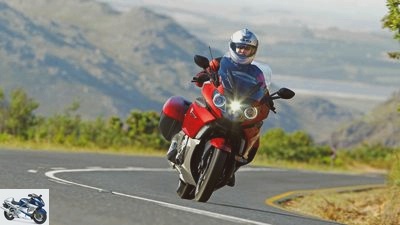
Gargolov
counselor
workshop
Workshop: light optimization
Workshop: optimize lighting
Shine better, see more
The subject of light is neglected by both motorcycle manufacturers and many drivers. It is worthwhile to improve the light output, because seeing and being seen better is particularly important in autumn and winter.
Markus Golletz
11/22/2012
Pimp the headlights, mount additional headlights, what is legal, what does the aftermarket offer – and what does the TuV say about it? The good news first: Nothing has to be entered as long as the original mounting position is retained and legal parts with the E mark are used that were installed in accordance with the mounting regulations. The lighting on many motorcycles is not the best. Especially when the autumn weather starts and the days get shorter.
Buy complete article
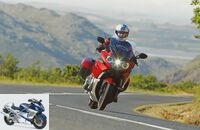
Workshop: optimize lighting
Shine better, see more
2 pages) as PDF
€ 2.00
Buy now
More light for little money
Double headlights, daytime running lights (DRL), xenon lights, full LED headlights or even laser light – while lighting technology in cars is advancing at full throttle, most motorcycle manufacturers often save on development costs for driving lights. It is assumed that motorcycles are hardly moved in the dark. As before, cheap no-name H4 lamps are often shimmering in series, and the most widespread innovation in recent years is clear-glass headlights. But action is better than complaining. The simplest way to gain more light is to simply wash the headlights: 20 percent more light can quickly be emitted, and apart from some work, that costs next to nothing. Next tuning level for more light on the bike: better light bulbs, both for H4 and H7.
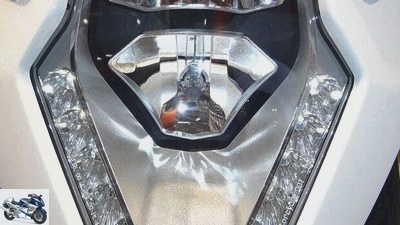
Picasa
Right on trend: the new KTM Adventure with LED strip as daytime running lights.
Somewhat more expensive brand name lamps, such as those from Philips or Osram, bring between 60 and 100 percent more light onto the road using conventional technology. Better glass bulb materials and fillings are responsible for this. Such high-end light bulbs can easily cost around 20 euros in stores, but the few euros more than for no-name cheap offers (from three euros) are very worthwhile. The clear glass headlights already mentioned also produce a higher light output than the corrugated glass variants of the last century. Check whether an exchange is possible via the accessories program, the prices for the clear glass versions are different, but retrofitting is possible from 35 euros plus any wages.
Incidentally, a completely new, E-approved main headlight with a suitable lamp goes through the next main inspection without an entry. Why the effort? To see better also means to be seen better, not unimportant in the dark season from autumn. Full-LED headlights (over 2000 lumens), which are very popular in cars, are increasingly becoming a trend for motorcycles as well, but are currently not yet approved in Germany, so it is worthwhile to improve your existing lighting system.
xenon
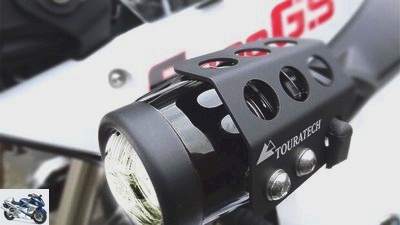
Picasa
Xenon light on the motorcycle? So far the exception. Additional headlights can be easily installed with the appropriate brackets.
Up to now, xenon lighting has been a tinkering room on the verge of legality. The most powerful lighting technology currently available for motorcycles is the xenon gas discharge lamp, which up to now has hardly been used, presumably for reasons of cost. Xenon headlights are considered to be extremely dazzling. And also as too expensive, after all, the Road Traffic Licensing Regulations (StVZO) prescribe automatic devices for headlight washing (cleaning) and automatic headlight range control (leveling), at least for the low beam, from a light output of 2000 lumens. Xenon gas discharge lamps are already available on the Internet as so-called conversion kits for existing H4 or H7 headlights – but without a general operating permit (ABE) for road traffic.
Installation is relatively easy. But be careful, you work with absolute high voltage – laypeople without electrical knowledge should rather refrain from such handicraft work. In any case, the power consumption of xenon technology is lower than that of halogen technology, only about five watts have to be added to the wattage (25/35 W) for the control electronics, while the light output is twice to three times higher (3200 lumens with 35 watt xenon) than with halogen light. In addition, the light color can be chosen when selecting the burner, a wide spectrum between cold (blue) light or light similar to daylight (6000 Kelvin) can be selected. This is what makes these conversion kits so attractive, which are available for around 40 euros, but which usually use 35 watt xenon burners.
However, lamps and headlights always have to be coordinated with one another and require a type approval, which of course is usually missing in the case of windy offers on sales portals on the Internet. So keep your hands off those conversions that cause a lot of trouble during a traffic control or at the latest during the next general inspection!
This does not apply to an ECE test “Cleaning” but with motorcycles already gone. Nevertheless, xenon lights are only available as special accessories for two models (BMW only), and even well-established suppliers such as Touratech or Wunderlich only offer xenon lights as high beam headlights. That could change soon: 25 watt xenon is the magic word. This technology has only recently come onto the market for mid-range automobiles, and recently this xenon light is available as a low beam even without an expensive automatic one “Leveling” allowed on motorcycle. It has significantly more lumens than the standard halogen lamp, but a slightly lower light output (a maximum of 2000 lumens are allowed) than 35 watt xenon. This opens up new avenues for series production or the aftermarket.
Headlights with approval
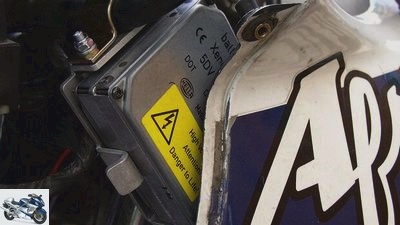
Golletz
Conversion kits for driving lights often require critical tinkering in order to accommodate ballasts.
At the moment, only xenon additional high beam headlights can be installed without any problems. These cost around 350 euros. When mounting, a bracket must be placed on the motorcycle and a ballast must be accommodated. Special mounting kits facilitate assembly and automatically adhere to the legally prescribed dimensions. The light is then ignited automatically with the high beam and only needs to be adjusted manually the first time. LED headlights are also often available as original accessories in the form of fog lights. Please note: They may only be switched on in certain weather conditions with poor visibility!
Daytime running lights for motorcycles
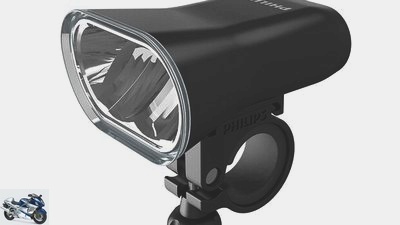
Golletz
Approved for light motorcycles: Philips Safe-Ride LED bicycle light.
Daytime running lights (TFL) on motorcycles pose a particular problem. The ECE-R 53 standard has not yet been transferred into German law, which is why all TFL sets on offer are currently installed on motorcycles, but may not be used in this country. Various attachment sets are already on the market, but are still waiting for the legislature to make an already announced change in the StVO. However, this change seems to be imminent, with some models coming onto the market with TFL as early as 2013 (e.g. BMW R 1200 GS or KTM Adventure 1190). However, according to the StVO, motorbikes should always drive with dipped headlights, but the daytime running lights must not burn together with the dipped headlights and must go out in the dark or must not have a manual switch.
Potential buyers will have to be patient for a while until the text of the law is improved, or speculate that the police will be kind during controls. TFL sets are not cheap, cost between 250 and 400 euros depending on the size (for example from Shin Yo, Touratech, Wunderlich), but may only be used in countries without such regulations.
A little glimpse into the future: More and more concept studies of new motorcycles (most recently BMW Concept C) are equipped with LED headlights or at least daytime running lights. So it is to be expected that at least TFL will soon become established. The situation is different with full-LED headlights, which, in addition to laser light, represent the next development stage in vehicles. The first series-ready products (for example from Audi) have their price: an impressive 2500 euros per headlight. Paaschburg & Wunderlich (Shin Yo-Shop) have an approved LED headlight (7-inch LED with high and low beam, E-approved) for 498 euros in their range.
Bicycle dealers can buy the Safe Ride 80 LUX LED front light for around 120 euros, which can be used on 125s. The most important addresses for motorcycle lamps:
Hein Gericke:
Tel. 02 11/9 89 89, www.heingericke.de
Louis:
Tel. 0 40/73 41 93 60, www.louis.de
Osram:
Tel. 0 89/6 21 30, www.osram.de
Paaschburg & Wunderlich (Shin Yo-Shop):
Telephone 0 40/2 48 27 70, www.brands4bikes.de
Philips:
Tel. 0 08 00/74 45 47 75 (free hotline), www.philips.de
Polo:
Tel. 0 21 65/8 44 02 00, www.polo-motorrad.de
Touratech:
Tel. 0 77 28/9 27 90, www.touratech.de
Whimsical:
Tel. 0 26 42/9 79 80, www.wunderlich.de
Related articles
-
Redcat Repeater H1 brake light on the motorcycle helmet
Redcat 21 pictures Redcat 1/21 The Redcat Repeater H1 is an external brake light that can be retrofitted to the helmet. Redcat 2/21 The series product is…
-
Frog helmet holder – small, light and award-winning
Frog 24 pictures Frog 1/24 The idea for the Frog helmet holder came up six years ago. Frog 2/24 The team from Barcelona worked on the perfect shape and…
-
KSH – smart open face helmet with headset and brake light
News 2022 New motorcycle items for 2022 Kosmos Smart Helmets 6th pictures Kosmos Smart Helmets 1/6 In the event of a fall, the helmet contacts the rescue…
-
Workshop gloves for screwing on the motorcycle
fact 22nd pictures mps photo studio 1/22 Ejendals Tegera 5117: Price: 10.90 euros. MOTORRAD verdict: very good. mps photo studio 2/22 Ellix 397627:…
-
Advice: workshop – repair ignition box
Ury accesories Advice: workshop – repair ignition box Guide: workshop Repair ignition box Ignition control failure can be surprisingly expensive – but it…
-
BMW recall for USA and China: safety rear light is not permitted
BMW counselor traffic & business BMW recall for USA and China: safety rear light is not permitted BMW recall for USA and China Safety rear light is not…
-
Brembo turns 60 and lets the brakes light up
Brembo 15th pictures Brembo 1/15 Brake specialist Brembo is celebrating its 60th birthday with a new brake caliper concept. Brembo 2/15 Brembo calls the…
-
Workshop guide: hoses and clamps
Schermer counselor workshop Workshop guide: hoses and clamps Workshop guide Hoses and clamps To ensure that air, fuel and coolant get exactly where they…
-
Time limits for motorcycle repairs workshop
markus-jahn.com counselor traffic & business Time limits for motorcycle repairs workshop Timing for motorcycle repairs Over time it gets annoying When it…
-
Bilski 44 pictures Bilski 1/44 “There is work going on here!” – Impressions from Mike Krons restoration workshop. Bilski 2/44 “There is work going on…